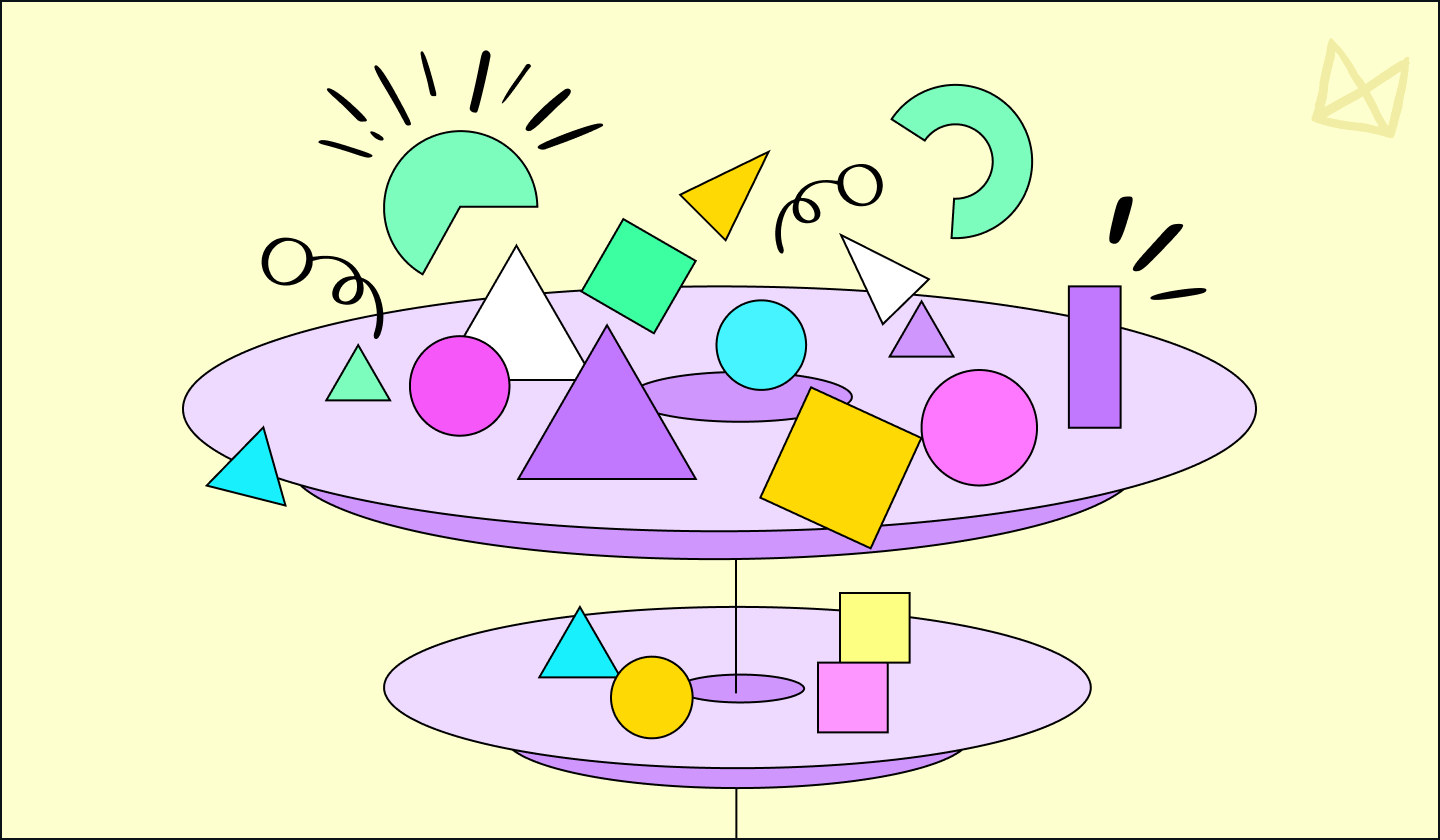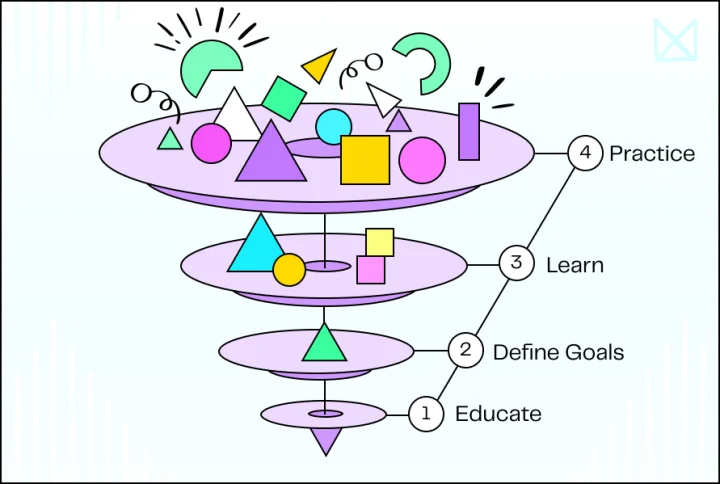Contents
“Being a human means we are not permanent.” Time changes us, knowledge changes us, certain life events and our environment change us. We change physically and mentally over time in all possible senses and directions. So dealing with inclusive design and accessibility is not a nice-to-have, it’s not just about caring towards different communities and practicing empathy. It is also about designing for our possible future selves.

At UX studio, we started our journey to shift our mindset and learn about the basics of Inclusive design and accessibility around 2022. Onboarding everyone is an ongoing, lengthy process. While we are only at the entrance, we are still proud enough of our first steps to share our learnings.
The inclusivity scale
There are always two (or multiple) sides to a coin. On the one hand, we were happy that, as a Product design agency, we don’t need to start from ground zero. Our profession inherently thrives on inclusivity. It’s part of our job to study and learn about all possible aspects of a problem space with empathy at the forefront. We talk to people, we consider edge cases, and empathy is a core value to pursue. The basics of accessibility are also injected into our practice: readability and caring about the proper color contrast is a baseline, while prototyping and usability testing are part of our process by default.
However, when I first read Janey Lee’s article about the conscious uncentering of her design practice at Spotify, I realized that we are merely scratching the surface. Inclusive design and accessibility are not just about prioritizing minimum compliance with, for example, WCAG standards. There are a lot more dimensions to it.
The ability to design genuinely inclusive experiences starts at an individual level by identifying our own bubble and its limitations and consciously acting towards widening our perspective as a person and as a professional.

Educating ourselves and each other
We basically started an inclusive design study group with my squad when I was a squad lead. Our starting point was to get clear definitions and have a common understanding of Inclusivity as an umbrella term. I highly recommend Kat Holmes’s book, Mismatch, as it helped us understand the gravity and also the multiple layers of the topic. Our initial goal was to understand terms such as universal design, accessibility, inclusive design, WCAG, and assistive technology to align the basics. We wanted to clarify that inclusivity is not just about physical abilities versus disabilities but extends beyond age, color, and physical impairment. It includes sensory and cognitive diversity, cultural, economic, and social factors, emotional well-being, and the sense of belonging. And the list is even longer, and the categories depend on which approach you settle with.
As a next step, we decided to explore how we can incorporate inclusive design and accessibility in each stage of the design thinking process. We allocated 1-2 hours each week to join a call for synchronous reading and internet digging about currently available information and tried to make an organized compilation of resources and quick takeaways. The output was a simple collection of ideas, links, and examples that we found useful at the time. We presented and shared our learnings with each other and the team.
Shout-out to our colleague, Enikő, who facilitated the Inclusive mind-shift workshop for each squad at the company this year. 🥳

Early awareness lessons
Our main takeaways were mostly about identifying the limitations of our current product design and research processes and also the challenges of getting business buy-in for incorporating best practices.
The availability bias
We tend to test our solutions with an audience representing the average users. We should consciously examine edge cases with the “excluded” in mind, who could also be part of the potential audience of the products we are working on. Involving such groups could fuel great solutions for products in the discovery phase or products needing a new direction. Being more conscious about these groups when recruiting could also help find new inspiration for tackling problems.
However, the process of diversifying the pool of research participants can be challenging. One of the main challenges is being aware of the biases that could be present in the recruitment process. Recruitment platforms often have their own homogeneous pool of possible research participants, which can limit the diversity of the group being studied. Therefore, it is important to take back control over the process to ensure that it is fair and inclusive.
Careful with the trend train
It is also important to accept that whenever we jump on the “trend train,” we need to be careful. For example, while parallax design can make our designs highly compelling, they might cost too much when overdoing them.
Animation can cause mild or even severe motion sickness if it’s not done in a subtle way. There are a few aspects to make sure the design is accessible to more people:
- Make sure your sliders and carousels are easy-to-control
- Consider adding a “turn off or reduce motion” option to your solution
- Always consider the platforms you design for: what seems to be a slight motion on desktop, might be extremely triggering on mobile
- Provide an alternative content to your animations and visuals (this is also a default requirement for visuals, not just animations)
The business case behind caring about minorities
As a product design firm, it is hard to build a business case for diversity and inclusion. We need to help our clients understand the product and business opportunities of inclusivity. For example, how should the product change with the aging of the buying power audience? What are the current numbers, and what could be the market share of excluded groups, and how can we support them along the way? How does it contribute to your brand awareness and also trust? Can businesses prioritize at least one possibly excluded segment and allocate resources to building for them as well? Sidenote: This also raises other concerns, like how to choose a sidelined community over the other.
We need to get the message through that if we also design for the excluded, our solution usually works better for an even larger audience.
However, we understand that this decision also depends on the product life cycle. At UX studio, we build our own products as well, besides our client work. Our product teams mostly work on early-stage solutions, where the first task is to prove if the products are feasible. At this stage, laser focus and super strict prioritization are the norm, and it is more difficult to convince team members to broaden their thinking about their target audience besides the core early adopters. Check out one of our mentioned products here: Copyfolio
Universal design might be a utopia
When I started my career, universal design was a popular concept, and it still is. However, the idea of designing for a wide range of abilities and characteristics tends to result in some kind of a superficial “average” in mind, which is full of pitfalls. The one-size-fits-all approach is full of biases we may not even realize, and it’s inevitable to overlook certain user groups.
Inclusivity means embracing our stories, our relationships, and everything that affects us. Inclusive design owns the responsibility to listen to these stories and act on them without any ignorance or denial. It’s striving for acceptance and welcoming people, building trust. And it is hard. It’s also hard to admit and accept that you cannot meet everyone’s needs.
One of the very first things that Prof. Jonathan Hassel helped me understand in his book Inclusive Design for Products was that it is simply not efficient, mostly not even feasible, to try to serve everyone in the same way. It is a tough (stakeholder) decision to choose an overlooked group, a right niche, for the right reasons. However, it will have more impact both from a business and user perspective if done well. So forgiving ourselves for not tackling features like voice-over and transcript all at once is all part of the story. Creating an accessibility roadmap or objective might ensure you stay on the journey and always take one small step forward.
Walk the talk
When writing about inclusivity, I cannot separate the professional aspects from our company culture. We cannot discuss one without the other if we want this to be congruent and make sure that we really intend to walk the talk.
It is also great to embrace how our work determines our open attitude. As an international team, we are constantly learning about different cultures and communities. Each team member brings in a new perspective due to their background and context. We are open to debates and changes and strive to build a safe and brave environment.
However, our team could be more diverse from plenty of perspectives, and I am sure we inevitably overlook many opportunities because of that.
We are beginning our journey by examining our team, acknowledging their capabilities, experiences, and perceptions, and embracing the value their perspectives bring to all of us.
Our recent example is that we have a colleague who is a child of deaf parents. And I consider that as a gift to the team, an opportunity to learn about a community we rarely interact with. He was our motivation to start to connect with Sign Coders and figure out how we could learn from each other. Sign Coders is a software developer company employing deaf and hard of hearing IT professionals. We mentored their designer to help her journey into UX, and they are teaching us about their culture.

We started a lab project that originated from the need to learn about each other’s culture. Check the Culture Quilt idea to learn more about the importance of cultural intelligence and how we approached the topic with a simple pack of cards ♥️.
Sharing our lessons early on
The entire topic of inclusive design and accessibility is a lifelong journey, both personally and professionally. There is no place for maximalism here. We need to be brave enough to share our learnings early with each other. Whatever small advancement we take is already a win for someone using your design solution or implementing your learnings in their design & research process. Or entering your community.
We opened up the conversation by organizing a free event about the “Understanding Inclusivity: a shift in mindset” workshop, which we will repeat in the future as it was a great success. We also facilitated a workshop about “Prototyping for accessibility” multiple times. So make sure to follow us on Eventbrite to catch any upcoming events related to the topic.
In our UX studio podcast, we cover topics that we also would like to learn more about. In one of the episodes, the interview with Anna Mészáros, the Accessibility Lead at GoTo, also brought us closer to the topic of inclusivity. Follow Design Aloud on Spotify or Apple Music to stay tuned 🙂
When we tapped into the topic of inclusivity, we realized that we are already in the very middle of it, both professionally and company culture-wise. But only awareness and humility make it real and actionable. We have a long way to go, and it’s encouraging to see that we are on track and not alone. I’m sure we will come back with updates about this topic and share what we have learned.




